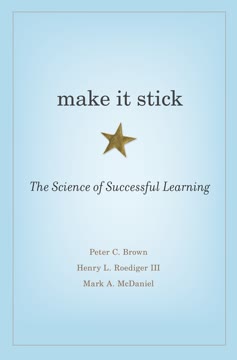Key Takeaways
1. Prioritize Your Most Important Tasks
Your "frog" is your biggest, most important task, the one you are most likely to procrastinate on if you don't do something about it.
Identify your frogs. Every day, you face a multitude of tasks and responsibilities. The key to success is identifying your most crucial, high-impact tasks - your "frogs" - and tackling them first. These are often the tasks you're most likely to procrastinate on, but they're also the ones that can make the biggest difference in your academic and personal life.
Eat that frog! Once you've identified your most important task, commit to completing it before moving on to less critical activities. This approach ensures that you're always making progress on your most significant goals, even if you accomplish nothing else that day. By consistently prioritizing and completing your most challenging tasks first, you'll build momentum, boost your confidence, and dramatically increase your overall productivity.
2. Take Full Responsibility for Your Success
Taking responsibility is one of the best things about growing up.
Embrace personal responsibility. As you progress through your academic career, you'll face a critical turning point: the shift from having others make decisions for you to taking full control of your life. This transition can be daunting, but it's also incredibly empowering. By accepting complete responsibility for your actions, choices, and outcomes, you gain the power to shape your future.
Focus on what you can control. While you can't control everything in your environment, you always have control over your reactions and responses. Instead of blaming external factors or making excuses, concentrate on what you can do to improve your situation. This mindset shift allows you to:
- Actively seek solutions to challenges
- Learn from mistakes and setbacks
- Continuously improve your skills and knowledge
- Develop resilience and adaptability
By taking ownership of your education and personal growth, you'll be better equipped to overcome obstacles and achieve your goals.
3. Set Clear, Written Goals
Nothing will propel you toward success faster than the practice of having clear, written goals.
Write down your goals. The simple act of putting your goals on paper dramatically increases your chances of achieving them. Use the "Three P Formula" when writing your goals:
- Present tense: Write as if you've already accomplished the goal
- Positive: Focus on what you want to achieve, not what you want to avoid
- Personal: Use "I" statements to make the goal your own
Make your goals specific and time-bound. Instead of vague aspirations, set concrete objectives with clear deadlines. For example, "I have an A in Chemistry by June 15th" is more powerful than "I want to do better in Chemistry."
Review and revise regularly. Keep your goals visible and review them daily. As you progress, update and adjust your goals to reflect your changing priorities and circumstances. This constant engagement with your goals helps maintain focus and motivation, propelling you toward success.
4. Plan Your Day in Advance
Planning is bringing the future into the present so that you can do something about it now.
Create daily to-do lists. Take 10-12 minutes each evening to plan your next day. This small investment of time can save you up to two hours of wasted effort the following day. Write down all your tasks and prioritize them based on importance and urgency.
Use different lists for different purposes:
- Master list: Capture all long-term goals and ideas
- Monthly list: Plan major tasks and deadlines for the coming month
- Weekly list: Break down monthly goals into weekly action items
- Daily list: Identify specific tasks to complete each day
By planning in advance, you'll start each day with clarity and purpose, knowing exactly what needs to be accomplished. This proactive approach reduces stress, increases focus, and helps you make consistent progress toward your goals.
5. Apply the 80/20 Rule to Everything
20 percent of your activities will account for 80 percent of your results.
Identify your high-impact activities. The Pareto Principle, or 80/20 Rule, suggests that a small portion of your efforts will produce the majority of your results. In your academic life, this might mean:
- 20% of your study time yields 80% of your learning
- 20% of your assignments account for 80% of your grade
- 20% of your extracurricular activities provide 80% of the value for college applications
Focus on the vital few. Once you've identified your high-impact activities, allocate more time and energy to these areas. This doesn't mean neglecting other responsibilities, but rather ensuring that you're investing your best efforts where they'll have the greatest impact.
Regularly reassess your priorities. As your circumstances change, so will your high-impact activities. Periodically review your tasks and commitments to ensure you're still focusing on the most important 20%.
6. Break Large Tasks into Manageable Steps
There is one quality which one must possess to win, and that is definiteness of purpose, the knowledge of what one wants and a burning desire to achieve it.
Use the "salami slice" method. When faced with a large, daunting task, break it down into smaller, more manageable pieces. This approach makes the overall task less overwhelming and allows you to make steady progress.
Create a detailed action plan. For each major project or goal:
- List all the steps required to complete the task
- Organize the steps by priority and sequence
- Set deadlines for each step
- Take immediate action on the first step
Maintain momentum. As you complete each small step, you'll build confidence and motivation to tackle the next one. This steady progress helps overcome procrastination and keeps you moving toward your larger goals.
7. Develop a Sense of Urgency
Do not wait; the time will never be "just right." Start where you stand, and work with whatever tools you may have at your command, and better tools will be found as you go along.
Cultivate a bias for action. Highly successful people are characterized by their ability to take quick, decisive action. Develop this habit by:
- Starting tasks immediately, without unnecessary delay
- Setting self-imposed deadlines for your work
- Challenging yourself to complete tasks faster than expected
Enter a state of flow. By working with urgency and focus, you can enter a highly productive mental state known as "flow." In this state, you'll feel energized, clear-headed, and capable of tackling even the most challenging tasks.
Create artificial deadlines. To increase your sense of urgency, imagine scenarios that require immediate action. For example, pretend you're leaving for a month-long trip tomorrow and need to complete all essential tasks before departing. This mental trick can help you prioritize and act with greater speed and efficiency.
8. Focus Your Attention and Avoid Multitasking
Focused attention is the key to high performance.
Eliminate distractions. The modern world is full of interruptions that can derail your productivity. Take control of your environment by:
- Turning off notifications on your devices
- Finding a quiet, dedicated study space
- Using website blockers to limit access to time-wasting sites
Practice single-tasking. Contrary to popular belief, multitasking is inefficient and can lead to more errors. Instead:
- Focus on one task at a time
- Work in concentrated blocks of time (e.g., 30-60 minutes)
- Take short breaks between tasks to recharge
Improve your ability to focus. Like a muscle, your ability to concentrate can be strengthened with practice. Try techniques like:
- Mindfulness meditation
- The Pomodoro Technique (25 minutes of focused work followed by a 5-minute break)
- Gradually increasing your periods of uninterrupted work
By cultivating deep focus, you'll complete tasks more efficiently and retain information more effectively.
9. Prepare Thoroughly Before Beginning
Proper preparation is like getting everything ready to prepare a complete meal. You set all the ingredients out on the counter in front of you and then begin putting the meal together, one step at a time.
Set up your workspace. Before starting any task, take the time to create an optimal work environment:
- Clear your desk of unnecessary items
- Gather all required materials and resources
- Ensure you have a comfortable, ergonomic setup
Plan your approach. Take a few minutes to outline your strategy for tackling the task:
- Break the task into smaller steps
- Identify potential challenges and solutions
- Set specific goals for the work session
Overcome perfectionism. While preparation is crucial, don't let it become an excuse for procrastination. Aim for "good enough" to get started, knowing you can refine your work as you progress.
By thoroughly preparing before you begin, you'll reduce stress, increase focus, and set yourself up for success from the outset.
10. Use Technology Wisely
Technology is just a tool.
Harness technology's potential. The digital age offers unprecedented access to information and tools that can enhance your learning and productivity. Take advantage of:
- Online learning platforms (e.g., Khan Academy, Coursera)
- Productivity apps for task management and scheduling
- Digital note-taking and organization tools
Avoid technology pitfalls. While technology can be a powerful ally, it can also be a significant source of distraction. Implement strategies to maintain control:
- Use website blockers during study sessions
- Set specific times for checking email and social media
- Practice digital detoxes to reset your focus
Continuously evaluate your tools. Regularly assess the effectiveness of the technology you're using:
- Commit to trying new tools for at least two months before switching
- Focus on consistency rather than constantly chasing the "next big thing"
- Consider analog alternatives (e.g., paper planners) if digital tools aren't working for you
By using technology intentionally and maintaining a balanced approach, you can leverage its benefits while avoiding its potential pitfalls.
11. Practice Creative Procrastination
Creative procrastination is one of the most effective of all personal performance techniques. It can change your life.
Procrastinate strategically. Since you can't do everything, choose wisely what to put off. Deliberately delay or eliminate low-value activities to make room for high-priority tasks.
Set "posteriorities." Just as you prioritize important tasks, actively decide what you'll do less of or not at all. This might include:
- Limiting time spent on social media
- Scaling back involvement in less impactful extracurricular activities
- Saying "no" to non-essential commitments
Regularly reassess your commitments. Use "zero-based thinking" to evaluate your activities:
- Ask yourself, "If I weren't doing this already, would I start doing it now?"
- Be willing to let go of activities that no longer align with your goals
- Focus your energy on tasks that provide the highest return on your time investment
By practicing creative procrastination, you create space for what's truly important, allowing you to make significant progress on your most valuable goals and responsibilities.
Last updated:
FAQ
What's "Eat That Frog! for Students" about?
- Focus on Procrastination: "Eat That Frog! for Students" by Brian Tracy is a guide specifically tailored for students to overcome procrastination and enhance productivity.
- 22 Strategies: The book presents 22 practical strategies to help students manage their time effectively and achieve academic success.
- Metaphor of Eating a Frog: The central metaphor of "eating a frog" represents tackling the most challenging and important task first to maximize productivity.
- Student-Centric Approach: It addresses the unique challenges students face, such as balancing academics with extracurricular activities and personal responsibilities.
Why should I read "Eat That Frog! for Students"?
- Practical Advice: The book offers actionable steps that students can implement immediately to improve their time management and productivity.
- Tailored for Students: It specifically addresses the pressures and challenges faced by students, making it highly relevant for those in high school, college, or graduate school.
- Proven Techniques: Brian Tracy draws on decades of experience in time management, providing strategies that have been tested and proven effective.
- Long-Term Benefits: By adopting the techniques in the book, students can develop habits that will benefit them throughout their academic and professional lives.
What are the key takeaways of "Eat That Frog! for Students"?
- Prioritize Tasks: Focus on the most important and challenging tasks first to maximize productivity and effectiveness.
- Set Clear Goals: Establish clear, written goals using the Three P Formula: present, positive, and personal.
- Manage Time Effectively: Use strategies like planning every day in advance and applying the 80/20 rule to focus on high-impact activities.
- Develop Self-Discipline: Cultivate habits of self-discipline and personal responsibility to achieve academic and personal success.
What is the "Eat That Frog" method in the book?
- Tackle the Hardest Task: The "Eat That Frog" method involves identifying and completing the most challenging and important task first.
- Boost Productivity: By addressing the biggest task early, students can increase their productivity and reduce procrastination.
- Psychological Benefit: Completing a difficult task first provides a sense of accomplishment and motivation to tackle other tasks.
- Daily Practice: The method encourages making this approach a daily habit to consistently improve time management skills.
How does Brian Tracy suggest students manage their time?
- Plan in Advance: Tracy emphasizes the importance of planning each day in advance to save time and increase efficiency.
- Use Lists: Create different lists for daily, weekly, and monthly tasks to stay organized and focused.
- Prioritize Tasks: Apply the 80/20 rule to identify tasks that will have the greatest impact on academic success.
- Schedule Study Blocks: Allocate specific time blocks for studying and completing assignments to maintain focus and productivity.
What are the Three Pillars of Success according to the book?
- Self-Esteem: Building unshakable confidence and self-esteem is crucial for achieving success and overcoming challenges.
- Personal Responsibility: Taking complete responsibility for one's actions and decisions is essential for personal and academic growth.
- Goal Orientation: Being relentlessly focused on setting and achieving clear goals is a key component of success.
How does the book address studying subjects of little interest?
- Consider Consequences: Understand the long-term benefits of doing well in all subjects, even those of little interest.
- Motivate Yourself: Use self-motivation techniques to find value and purpose in studying less interesting subjects.
- Break Tasks Down: Use methods like the "salami slice" or "Swiss cheese" techniques to make studying manageable.
- Focus on Results: Concentrate on the key result areas that will have the most significant impact on academic performance.
What are some of the best quotes from "Eat That Frog! for Students" and what do they mean?
- "Eat That Frog!": This quote encapsulates the book's central idea of tackling the most challenging task first to boost productivity.
- "Proper Prior Planning Prevents Poor Performance": Emphasizes the importance of planning and preparation in achieving success.
- "You cannot teach a man anything; you can only help him find it within himself": Highlights the importance of self-discovery and personal responsibility in learning.
- "The key to success is action": Stresses the importance of taking immediate and decisive action to achieve goals.
How does Brian Tracy suggest dealing with stress in the book?
- Prepare Thoroughly: Proper preparation and planning can significantly reduce stress and anxiety.
- Focus Attention: Eliminate distractions and focus on one task at a time to improve efficiency and reduce stress.
- Manage Technology: Use technology wisely to avoid becoming overwhelmed by notifications and digital distractions.
- Practice Creative Procrastination: Intentionally delay low-value tasks to focus on high-impact activities, reducing stress from overwhelming to-do lists.
What role does technology play in "Eat That Frog! for Students"?
- Terrible Master: Tracy warns that technology can be a major source of distraction and stress if not managed properly.
- Wonderful Servant: When used strategically, technology can enhance productivity and learning.
- Manage Notifications: Turn off unnecessary notifications to maintain focus and control over digital distractions.
- Use Learning Tools: Leverage online resources and educational tools to supplement learning and improve academic performance.
How can students apply the 80/20 Rule in their studies?
- Identify High-Impact Tasks: Focus on the 20% of tasks that will yield 80% of the results in academic performance.
- Prioritize Assignments: Spend more time on major projects and exams that significantly impact grades.
- Limit Low-Value Activities: Reduce time spent on tasks that contribute little to overall success.
- Enhance Efficiency: Use the rule to streamline study habits and focus on activities that drive the most progress.
What is the significance of setting goals in "Eat That Frog! for Students"?
- Clarity and Direction: Setting clear, written goals provides students with a sense of direction and purpose.
- Motivation and Focus: Goals motivate students to take action and stay focused on their priorities.
- Three P Formula: Goals should be present, positive, and personal to be most effective.
- Measure Progress: Regularly reviewing and adjusting goals helps students track their progress and stay on course.
Review Summary
Eat That Frog! for Students receives mostly positive reviews, with readers praising its practical advice on time management and productivity. Many wish they had read it earlier in their academic careers. The book offers simple, actionable steps to overcome procrastination and achieve goals. Some readers find the content repetitive or basic, but most appreciate its straightforward approach. The book's focus on personal responsibility and empowering students to make better choices is highlighted. Overall, it's recommended for high school and college students looking to improve their study habits and time management skills.
Similar Books










Download PDF
Download EPUB
.epub digital book format is ideal for reading ebooks on phones, tablets, and e-readers.














